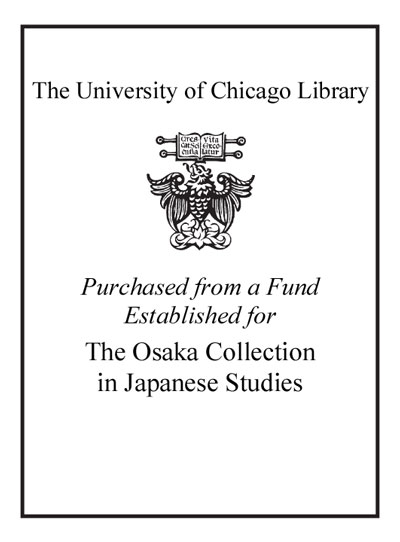Japanese gardens and landscapes, 1650-1950 /
Saved in:
| Author / Creator: | Kuitert, Wybe, author. |
|---|---|
| Imprint: | Philadelphia : University of Pennsylvania Press, [2016] ©2016 |
| Description: | ix, 372 pages : illustrations (chiefly color), maps (chiefly color) ; 23 x 27 cm. |
| Language: | English |
| Series: | Penn studies in landscape architecture Penn studies in landscape architecture. |
| Subject: | |
| Format: | Print Book |
| URL for this record: | http://pi.lib.uchicago.edu/1001/cat/bib/11358083 |
MARC
| LEADER | 00000cam a2200000 i 4500 | ||
|---|---|---|---|
| 001 | 11358083 | ||
| 003 | ICU | ||
| 005 | 20171222145503.4 | ||
| 008 | 151005t20162016pauab 001 0 eng c | ||
| 010 | |a 2015038845 | ||
| 019 | |a 948336286 |a 980915204 | ||
| 020 | |a 9780812244748 | ||
| 020 | |a 0812244745 | ||
| 035 | |a (OCoLC)923728116 |z (OCoLC)948336286 |z (OCoLC)980915204 | ||
| 040 | |a PU/DLC |b eng |e rda |c PAU |d DLC |d OCLCF |d BDX |d BTCTA |d YDXCP |d ERASA |d YDX |d GUA |d CHVBK |d ORU |d OCLCO |d RCE | ||
| 042 | |a pcc | ||
| 043 | |a a-ja--- | ||
| 050 | 0 | 0 | |a SB458 |b .K84 2016 |
| 082 | 0 | 0 | |a 635.0952 |2 23 |
| 100 | 1 | |a Kuitert, Wybe, |e author. |0 http://id.loc.gov/authorities/names/nr89011810 |1 http://viaf.org/viaf/15009764 | |
| 245 | 1 | 0 | |a Japanese gardens and landscapes, 1650-1950 / |c Wybe Kuitert. |
| 264 | 1 | |a Philadelphia : |b University of Pennsylvania Press, |c [2016] | |
| 264 | 4 | |c ©2016 | |
| 300 | |a ix, 372 pages : |b illustrations (chiefly color), maps (chiefly color) ; |c 23 x 27 cm. | ||
| 336 | |a text |2 rdacontent |0 http://id.loc.gov/vocabulary/contentTypes/txt | ||
| 336 | |a still image |b sti |2 rdacontent |0 http://id.loc.gov/vocabulary/contentTypes/sti | ||
| 337 | |a unmediated |2 rdamedia |0 http://id.loc.gov/vocabulary/mediaTypes/n | ||
| 338 | |a volume |2 rdacarrier |0 http://id.loc.gov/vocabulary/carriers/nc | ||
| 490 | 1 | |a Penn studies in landscape architecture | |
| 504 | |a Includes bibliographical references (pages 339-353) and indexes. | ||
| 505 | 0 | |a Landscape enjoyed at ease -- Garden stuff and blueprints for the masses -- Time and space in a cup of tea -- Defining the Japanese garden: science, vacuum, and confusion -- Passion and emotion in the Meiji landscape -- Reforming the tradition -- Everybody's landscape -- Epilogue: the cricket cage -- Notes -- Bibliography -- General index -- Index of plants -- Acknowledgments. | |
| 520 | 8 | |a Moss, stone, trees, and sand arranged in striking or natural-looking compositions: the tradition of establishing and refining the landscape has been the work of Japanese gardeners and designers for centuries. In Japanese Landscapes and Gardens, 1650-1950 Wybe Kuitert presents a richly illustrated survey of the gardens and the people who commissioned, created, and used them and chronicles the modernization of traditional aesthetics in the context of economic, political, and environmental transformation. Kuitert begins in the Edo period (1603-1868), when feudal lords recreated the landscape of the countryside as private space. During this same period, and following Chinese literary models, scholars and men of letters viewed the countryside itself, without any contrivance, as the ideal space in which to meet with friends and have a cup of tea. Stewards of inns, teahouses, and temples, on the other hand, followed increasingly cliched garden designs prescribed in popular, mass-produced pattern books. 0Over the course of the late nineteenth and early twentieth centuries, the newly wealthy captains of industry in Tokyo adopted the aesthetic of the feudal lords, finding great appeal in naturalistic landscapes and deciduous forests. Confronted with modernization and the West, tradition inevitably took on different meanings. Westerners, seeking to understand Japanese garden culture, found their answers in the pattern-book cliches, while in Japan, private landscapes became public and were designed in environmentally supportable ways, all sponsored by the government. An ancient, esoteric, and elite art extended its reach to every quarter of society, most notably with the extensive rebuilding that occurred in the aftermath of the Tokyo earthquake of 1923 and the end of World War II. In the wake of destruction came a new model for sustainable public parks and a heightened awareness of ecological issues, rooted above all in the natural landscape of Japan. 0. | |
| 650 | 0 | |a Gardens, Japanese |x History. | |
| 650 | 0 | |a Gardens |z Japan |x History. | |
| 650 | 7 | |a Gardens. |2 fast |0 (OCoLC)fst00937895 | |
| 650 | 7 | |a Gardens, Japanese. |2 fast |0 (OCoLC)fst00937981 | |
| 650 | 7 | |a Japanischer Garten |2 gnd | |
| 650 | 7 | |a Garten |2 gnd | |
| 650 | 7 | |a Landschaft |2 gnd | |
| 651 | 7 | |a Japan. |2 fast |0 (OCoLC)fst01204082 | |
| 651 | 7 | |a Japan |2 gnd | |
| 655 | 7 | |a History. |2 fast |0 (OCoLC)fst01411628 | |
| 830 | 0 | |a Penn studies in landscape architecture. |0 http://id.loc.gov/authorities/names/n98040965 | |
| 903 | |a HeVa | ||
| 929 | |a cat | ||
| 999 | f | f | |i f0d14757-1d4f-5ca5-8f7a-67a67a544ab2 |s f831e994-a765-50aa-a563-5b5ef289ad61 |
| 928 | |t Library of Congress classification |a SB458.K84 2016 |p f |l JCL |c JCL-Sci |i 10529370 | ||
| 927 | |t Library of Congress classification |a SB458.K84 2016 |p f |l JCL |c JCL-Sci |e OSAK |e CRERAR |b 114116864 |i 9866021 | ||


